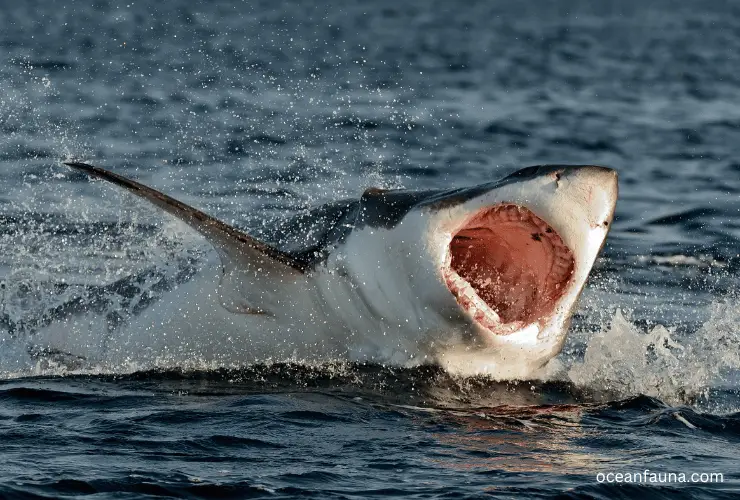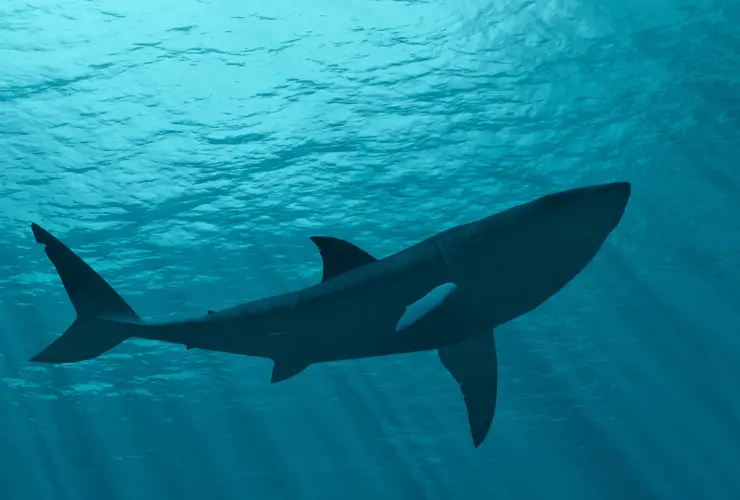It depends on the shark’s size when it’s about to swim in shallow water. The smaller the shark is, the shallower it can swim.
Now, the question is, at what depth can a shark swim when it comes to shallow water? Don’t worry. This article will answer all of them in detail.
How Shallow Can Sharks Swim?
Sharks come in many different sizes and shapes, and some species can swim in much shallower water than others. In general, smaller sharks can swim in as little as 1 foot of water, while larger ones may need at least 3 feet. For example, dogfish and hammerheads are small sharks that often hunt in sandy shallows that are no more than one foot deep.
Other large sharks like tiger sharks, and bull sharks, except great white sharks, on the other hand, tend to like deeper water and need at least 3 feet of depth to be able to hunt. Great white sharks need around 15 feet of water.
Not only does shallow water limit how far a shark can dive, but it also changes what kinds of animals it can catch. Small fish like anchovies and sardines tend to live in shallow water, while bigger fish like tuna tend to live further out in the ocean.

Sharks have to change how they hunt depending on what they can find to eat. Sharks close to shore are probably looking for smaller fish than sharks out in the open ocean.
The environment, like temperature and salinity, has a big effect on shark behaviour, so even if they can get to shallow water, they might not always go there if the conditions aren’t good for them. In places where it is colder or where there is more salt in the water, sharks may swim deeper to find more of their favourite food or to be more comfortable.
So, no matter how big the sharks in an area are, look at all the environmental factors when figuring out how shallow they can safely swim.
Why Do Sharks Swim in Shallow Water?
Sharks typically prefer shallow waters for a variety of reasons. Firstly, these areas generally offer the warmest temperatures for them to inhabit, as the shallower depths are heated by the sun more quickly than those in deeper water.
Secondly, there is often an abundance of prey for them to feed upon in shallower areas, including fish and other marine animals that might take refuge among nearby coral reefs or seagrass beds.
Last but not least, shallow waters provide a more confined space for sharks to hunt and ambush their prey, giving them an advantage over their target species.
In addition to providing ideal environmental conditions and abundant food sources, shallow waters also often feature dim lighting due to the reduced depth compared to deeper waters. This makes it easier for sharks to remain hidden until they make a move on their unsuspecting prey.
How Fast Do Sharks Swim?
The average speed of sharks is around 11-12 mph. But this speed is not exact for all sharks. It depends upon the species of sharks.
For example, the maximum speed of great white sharks for short bursts ranges around 25-35 mph. Don’t think they are the fastest. Shortfin mako sharks are the fastest sharks that can swim in both long and short bursts at 56 km or 35 mph.

Other sharks, like tiger sharks, swim around 20 mph, and bull sharks can swim within a range of 5-25 mph.
Shark speed depends on the size and species of shark, what they’re doing, and how far from shore they are. Sharks in shallow water will swim more slowly than sharks in the open ocean because there is less room to move around and stay away from predators.
How High Can Sharks Jump?
The height at which sharks can jump out of the water depends on the species and size of the shark. For example, adult mako sharks can give a jump of more than 9 meters (30 feet) in the air, while basking sharks can jump up to 2 meters (7 feet).
Great white sharks are known to jump up 16 to 19 feet (5 meters) above the surface of the water. Thresher and spinner sharks also display this behaviour but not as often as mako or great whites.
Jumping is not natural for all shark species, but it is commonly seen in predatory species such as mako and great white sharks. This type of jumping appears to be used for hunting, with some species using it to catch prey from above.
Great whites are especially adept at breaching, which involves leaping out of the water with their mouths open wide to snatch unsuspecting seals or sea lions from the ocean’s surface.
Mako sharks may use their vertical jumps as an attempt to catch fast-swimming fish such as tuna or mackerel before they reach shallow depths. While other shark species may leap out of the water for various reasons, data suggests that predatory instincts are usually behind these remarkable jumps.
Why Can’t Sharks Swim Backwards?
Sharks cannot swim backwards because of their pectoral fins. Unlike the pectoral fins of a fish, which can bend up and create thrust in any direction, a shark’s pectoral fins are not able to bend upwards. This limits the amount of thrust they generate and restricts a shark’s swimming ability to forward motion.
Additionally, sharks have no special swimming muscles as fish do; instead, they rely on the movement of their fins and tail to produce thrust. As a result, sharks must use gravity to fall to move backwards rather than swimming backwards with propulsion from their fins.
How Do Sharks Swim?
Sharks swim using a unique movement called “thrashing”, where they move their bodies side-to-side in an alternating motion. This undulating motion allows them to glide through the water efficiently and quickly.

The thrashing movement helps leverage the power of their tail fin, which is larger and more muscular than a fish’s, to propel them forward. Their dorsal fins also help by providing stability and control, while the pectoral fins act as rudder-like stabilizers that allow them to turn quickly in any direction.
Sharks’ anatomy is perfectly suited for swimming; their torpedo shape body design and lack of swim bladder provide maximum hydrodynamic efficiency, allowing them to travel long distances and reach impressive speeds with relatively little energy expenditure.
Can Sharks Get You in Shallow Water?
Yes, sharks can get you in shallow water. While shark attacks are far less frequent than most people think, they can and do occur in shallow water. Typically, these attacks are more likely to happen when a swimmer is mistaken for prey by the shark. This is especially true for smaller species of sharks, such as blacktip or spinner sharks, which often hunt in shallow coastal areas.
In addition to mistaking a swimmer for prey, there are other possible reasons why a shark might attack in shallow waters. Sharks may be driven into shallower depths due to increased human presence or activities like fishing or boat traffic that may disrupt their natural habitat.

Low visibility can also be a factor. If the water is cloudy or murky, it may be harder for the shark to identify a potential threat, leading them to attack out of confusion or fear. Additionally, many swimming areas have a higher concentration of baitfish which can draw hungry sharks into shallow waters looking for an easy meal.
Finally, some encounters with humans may escalate if the shark has been intentionally fed by people at some point in time, as this will encourage them to approach humans and increase their chance of attacking. In such cases, even small and non-aggressive species of sharks may become more dangerous when encountered by swimmers.
What Depth of Water Do Most Shark Attacks Occur?
Most shark attacks occur in 6 to 10 feet of water, which is the most common depth for these kinds of attacks. This is followed by 11 to 20 feet and zero to 5 feet, respectively. According to the International Shark Attack File, more than 60% of recorded shark attacks occur at depths of less than 25 feet.
Shallow water (less than 3 feet) is also known as a risk factor for shark attacks due to increased visibility and accessibility from shorelines.
Additionally, this depth range coincides with popular swimming, surfing, and bodyboarding activities. People wading and swimming in shallow waters are particularly vulnerable because they are closer to the sharks’ food source.
How Close to The Shore Do Sharks Swim?
Sharks typically swim between 6 and 100 feet close to the shore, although some species may come even closer. According to The Florida Museum of Natural History, most shark attacks occur between 6 and 10 feet from the shoreline.
Sharks are attracted to shallow waters because they offer plentiful food sources such as fish, crustaceans, and molluscs. They can also take advantage of warm water temperatures for reproduction or resting.

Adult sharks often hunt in deeper water but return to the shallows at night. Shark species that prefer shallow waters include bull sharks, tiger sharks, lemon sharks, nurse sharks, sandbar sharks, and blacktip reef sharks.
Depending on a particular area’s species and population density, some areas may be more populated with sharks than others. For example, South Africa’s False Bay is a well-known hotspot for great white shark activity due to its abundant seal populations.
Do Sharks Attack Humans from Below?
No, sharks do not typically attack humans from below. Sharks are usually attracted to objects that are unfamiliar in their environment, such as jewellery or a surfboard. When they investigate these objects, they may mistake a human for prey, leading to an attack.
However, most shark attacks happen when the shark is attacking from the side or above the surface of the water. Sharks attack from below because it allows them to remain camouflaged and quickly accelerate toward their prey before they are seen.
This tactic does not work on humans since we can clearly see predators coming from underwater, even if they are camouflaged.
Conclusion
Hopefully, you understand that sharks swim in shallow water their size. As you can see, sharks have adapted to a wide variety of environments with different water depths. Many attacks occur in shallow water due to easy accessibility and abundant food sources, most of which occur between 0 and 25 feet.
So be aware of your surroundings while swimming near shorelines, as this is where many shark species prefer to hunt. Understanding their habits and behaviours can help you stay safe when entering the ocean.


8 thoughts on “How Shallow Can Sharks Swim?”